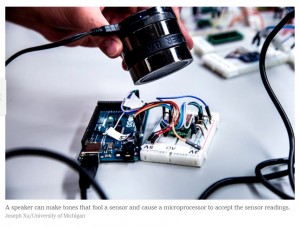Brother Dennis, apparently in a Iowa farm-nostalgic reverie, directs my attention to a 1938 Minneapolis-Moline “comfortractor”, intended originally to serve dual purposes as both farm utility implement and as roadworthy passenger vehicle. One of these rarities already sold at auction for $200,000. Read more here. 
Day: March 15, 2017
Gekeler Potholes
QR Code Spoofing and Related Security Issues
For years and years, my internet provider colleagues and I have preached about phishing and other ways that unwitting email and web users click on links that are not what they purport to be or are otherwise harmful. And, ever since they came into existence quite a few years ago, I have advised web clients to place QR codes into their printed material, like newspaper ads and business cards, so that QR reader software — typically built into or easily installed into devices like smartphones — can be used to scan and automatically jump to web addresses encoded and embedded in the QR codes. Turns out that QR codes, affixed to physical objects that their creators cannot easily control, can be replaced by fake QR codes that mis-direct users, such as codes attached to rental bicycles, or route payments made by smartphone, as described in this article about such security issues in China.
SIDEBAR: What is a QR code? QR stands for “Quick Response”, to begin with. It is a matrix of black dots on a white square background, and is commonly seen in magazine and newspapers ads to encapsulate a web or email address that is activated when scanned by software such as an app on your smartphone. Here is a (safe) example that would jump you to a Wikipedia page upon scanning:
Hacking with Sound Waves
 Seems that it is possible, like how an opera singer breaks a champagne glass with a high note, according to this NYT article.
Seems that it is possible, like how an opera singer breaks a champagne glass with a high note, according to this NYT article.
The Non-Digital Interconnectedness of Things
Continuing (from the previous post) with the theme of how One Darn Thing Leads to Another …
Last night, I watched episode four of HBO’s new series, “Big Little Lies” (Kim bailed after the third episode, but I still find it intriguing). In one scene, the background music brought my ears immediately to attention — it was a verse from Jefferson Airplane’s 1967 “White Rabbit”.
And, of course, this brought to mind some previous White Rabbit-ness as blogged here a few years ago.
Then this morning I find an totally unrelated email from Bill, my old photography partner in LA, not having heard from him for a week or so, in which he directed (as he often does) my gaze to a story and a related YouTube video, this time a long-lost vocals-only track of Grace Slick, the ‘Airplane’s lead singer doing, yes, “White Rabbit” (and he suggests listening via headphones):
And on it goes …
Dogfish, the Codfather and Iowa
Regular readers and family know that my niece Gabrielle has lived for years in the Cape Code region and has been close to the fishing industry there. And other relatives hail from nearby Boston.
Last night we saw an encore piece on the PBS Newshour about the problem of sustainable fishing in that part of the world and efforts to promote harvesting of plentiful species such as “dogfish”.
One of the purveyors cited in the piece as promoting sustainable species was an organization called Sea to Table. So I immediately looked up the website and dashed off email to inquire about dogfish. When I awoke this morning, I found that I had a cheerful and detailed response from Eliza of Sea to Table, telling me that dogfish is among the seafood that they intend to make available for home delivery, along with the half-dozen or so core species now on the mail-order menu.
No sooner than I closed that message and turned to reviewing the morning news, I came across this fascinating MoJo piece on “The CodFather”.
But, wait: there’s more! Next I see another MoJo piece on Iowa fish farming, of all things. Iowa, the birthplace of not only Gabrielle, but her father, and, of course, myself.

